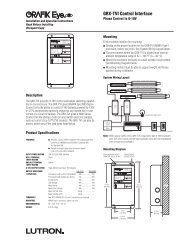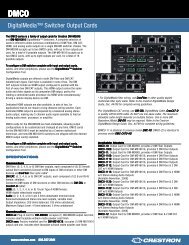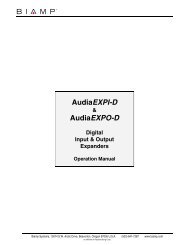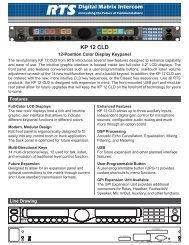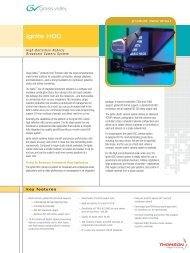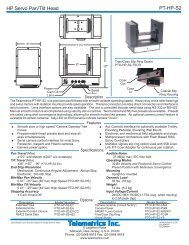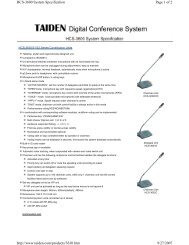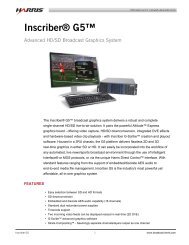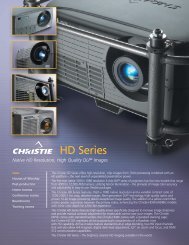MultiView UTx - products.isc365.com
MultiView UTx - products.isc365.com
MultiView UTx - products.isc365.com
You also want an ePaper? Increase the reach of your titles
YUMPU automatically turns print PDFs into web optimized ePapers that Google loves.
magenta<br />
M A G E N T A R E S E A R C H<br />
The Reliable One<br />
<strong>MultiView</strong> <strong>UTx</strong><br />
Universal Transmitter<br />
Quick Reference<br />
&<br />
Setup Guide<br />
TM<br />
MAGENTA RESEARCH LTD<br />
934 Federal Road, Brookfield, CT 06804 USA<br />
(203) 740-0592 FAX (203) 740-0596<br />
www.magenta-research.com<br />
MAGENTA RESEARCH<br />
934 Federal Road, Brookfield, CT 06804 USA<br />
(203) 740-0592 FAX (203) 740-0596<br />
www.magenta-research.com
Quick Reference & Setup Guide<br />
Thank you for your purchase of the Magenta Research <strong>MultiView</strong> <strong>UTx</strong> Universal<br />
Transmitter. The <strong>MultiView</strong> <strong>UTx</strong> transmitters are designed for plug and play operation.<br />
Fully compatible with all versions of the <strong>MultiView</strong> Series of single and multi<br />
port CAT5/5e/6 receivers, CAT5/5e/6 switches, and distribution amplifiers, the<br />
<strong>MultiView</strong> <strong>UTx</strong> transmitter is designed for quick and easy installation.<br />
Featuring field configurable technology, The Magenta Research <strong>UTx</strong> Universal<br />
Transmitter can be quickly and easily re-configured for other modes of operation.<br />
NOTE: CAT5/5e/6 cabling must be pinned to the TIA-EIA T568B wiring<br />
specification. This equipment is not intended for, nor does it support<br />
connection through an ethernet network. Do not connect these devices<br />
to any sort of networking or telecommunications equipment (see<br />
Appendix A for pinning specification).<br />
Refer to the diagram below, connect all appropriate cables, then apply power.<br />
Figure 1: <strong>MultiView</strong> <strong>UTx</strong> Cabling Diagram<br />
Magenta Research and the Magenta Research logo are trademarks of Magenta Research.<br />
All other brands, product names, and trademarks are the property of their respective owners.<br />
© 1998-2005 by Magenta Research All rights reserved.<br />
Magenta Research<br />
934 Federal Road<br />
Brookfield, CT 06804 USA<br />
This document and the Magenta Research <strong>products</strong> to which it relates, and the copyright in each, is<br />
the property of Magenta Research. Neither the document nor the <strong>products</strong> may be reproduced by<br />
any means, in whole or in part, without the prior written permission of Magenta Research. Magenta<br />
Research makes no warranty or representation, either express or implied, with respect to this software<br />
or documentation, including their quality, performance, merchantability, or fitness for a particular purpose.<br />
As a result, this software or documentation are licensed "as is" and you, the licensee, are<br />
assuming the entire risk as to their quality and performance.<br />
In no event will Magenta Research be liable for direct, indirect, special, incidental, or consequential<br />
damages arising out of the use of or inability to use the software or documentation.<br />
All trademarks are the property of the respective owners.<br />
CAT5<br />
(RJ45)<br />
Signal OUT<br />
(15HDF)<br />
Signal IN<br />
(15HDF)<br />
Audio or<br />
Simplex<br />
Serial<br />
(phoenix)<br />
Power IN<br />
(5VDC)<br />
Optional<br />
Full Duplex<br />
SERIAL<br />
(DB9F)<br />
1
MAGENTA RESEARCH<br />
Quick Reference & Setup Guide<br />
The <strong>MultiView</strong> <strong>UTx</strong> Universal Transmitter is field configurable for the following options:<br />
(The following lists the supported configurations of the <strong>UTx</strong>. Configurations outside<br />
of this list are not supported by Magenta Research). If you need to change the<br />
transmitter signal input, please refer to Table 2.<br />
Table 1: <strong>MultiView</strong> <strong>UTx</strong> Universal Transmitter Configuration Options<br />
<strong>UTx</strong> Universal Transmitter Setting<br />
<strong>MultiView</strong> Receiver Unit to use<br />
1) RGBHV Video <strong>MultiView</strong> MV250 AK500A, AK1000, AK1500<br />
2) RGBHV Video & L/R Audio <strong>MultiView</strong> MV250 AK500A, AK1000A, AK1500A<br />
3) RGBHV Video & SPDIF Digital Audio <strong>MultiView</strong> MV250 AK500SPDIF, AK1000SPDIF, AK1500SPDIF<br />
4) RGBHV Video & Simplex Uni Serial option) <strong>MultiView</strong> MV250 AK500S, AK1000S, AK1500S (*specify simplex serial option)<br />
5) YPrPb, Y/C, or Composite Video & L/R Audio <strong>MultiView</strong> MV250 AK500CS/A, AK1000CS, AK1500CS<br />
6) YPrPb, Y/C, or Composite Video & SPDIF Audio <strong>MultiView</strong> MV250 AK500CS/SPDIF, AK1000CS/SPDIF, AK1500CS/SPDIF<br />
7) YPrPb, Y/C, or Composite Video & Simplex Uni Serial <strong>MultiView</strong> MV250 AK500CS/S, AK1000CS/S, AK1500CS/S, AK1500S<br />
(*specify simplex serial option)<br />
8) Composite Video & Stereo Audio <strong>MultiView</strong> MV250 AK500AV, AK1000AV, AK1500AV<br />
(do not use phoenix connector — all signals input via HD15)<br />
Figure 2: <strong>MultiView</strong> <strong>UTx</strong> Jumper<br />
Locations and Settings<br />
Note: SW3 off position is down<br />
Table 2: <strong>MultiView</strong> <strong>UTx</strong> Universal Transmitter Configuration Jumper Settings<br />
Configuration Option: JP1 JP2 JP5 SW3 JP6 JP7 JP8<br />
1) RGBHV Video (or if separate daughterboard in) None None None A,B Off IN IN IN<br />
2) RGBHV Video & L/R Audio 3-4 5-6, 7-8 None A,B ON IN IN IN<br />
3) RGBHV Video & SPDIF Digital Audio 1-2 5-6, 7-8 1-2 A,B Off IN IN IN<br />
4) RGBHV Video & Simplex Uni Serial 5-6 5-6, 7-8 3-4 A,B Off IN IN IN<br />
5) YPrPb, Y/C, or Composite Video & L/R Audio 3-4 5-6, 7-8 None A,B On IN IN IN<br />
6) YPrPb, Y/C, or Composite Video & SPDIF Audio 5-6 5-6, 7-8 1-2 A,B Off IN IN IN<br />
7) YPrPb, Y/C, or Composite Video & Simplex Uni Serial 5-6 5-6, 7-8 3-4 A,B Off IN IN IN<br />
8) Composite Video & Stereo Audio None None None A,B Off OUT IN OUT<br />
(do not use Phoenix connector — all signals input via HD15)<br />
Troubleshooting:<br />
In most cases, issues with <strong>MultiView</strong> can be resolved by checking the CAT5/5e/6<br />
cable termination and ensuring it is pinned to the specification shown in<br />
Appendix A. Below are the most common installation errors:<br />
No video signal at transmitter local port and/or at receiver :<br />
- Check that both units are powered.<br />
- Ensure that the CAT5/5e/6 cable is terminated correctly per the specification<br />
shown in Appendix A.<br />
- Check that the display device is powered on and functioning.<br />
- In some cases, the sync termination may be mismatched. <strong>MultiView</strong> ships with<br />
75 Ohm termination as the default. See Appendix B to disable termination.<br />
Poor video quality:<br />
- Ensure the compensation switch on receiver is in the correct position.<br />
- Check cable connections.<br />
- Refresh rate of video signal may be set too high.<br />
- Delay Skew issue; see section titled “Delay Skew in UTP cables”.<br />
Poor audio quality:<br />
- Amplified speakers are required. Ensure speaker power is on.<br />
- Check input source levels from source device. Make sure the audio source is<br />
not over or under driven.<br />
- Supported audio signals are line level, unbalanced (contact Magenta Research if<br />
mic/speaker levels are required).<br />
Serial communication does not work correctly:<br />
- Ensure serial devices are connected properly and serial parameters are correct<br />
for source/destination devices.<br />
- Ensure serial cables are terminated correctly. If a Null Modem cable is used, it<br />
must be placed at the Receiver end.<br />
- When using <strong>UTx</strong> transmitters in simplex Uni serial mode or T4 Transmitters or<br />
DP Receivers the serial signal is a unidirectional broadcast mode only. In this<br />
mode, all other <strong>MultiView</strong> devices must be simplex serial type. Contact Magenta<br />
Research for assistance.<br />
- The last device in T4 or DP mode must be a standard or DP Receiver unit with<br />
a terminated Serial Board. Contact Magenta Research for assistance.<br />
2 3
MAGENTA RESEARCH<br />
Quick Reference & Setup Guide<br />
Troubleshooting (con’t):<br />
Green Shift / Green Washout on Multimedia Signals:<br />
The standard <strong>MultiView</strong> is designed to function with DC coupled signals with the<br />
black level referenced to 0 volts. Nearly all VGA cards function this way.<br />
However, some media servers or digital camera devices provide AC coupled signals<br />
and can cause a green color shift in the video. This is a result of the sync<br />
clamping on the Red and Blue channels in the <strong>MultiView</strong>. The <strong>MultiView</strong> <strong>UTx</strong><br />
Universal transmitter has been designed with full DC restore capability. A simple<br />
switch setting change is all that is required. See Appendix C for details.<br />
Appendix A:<br />
T568B CAT5/5e/6 Wiring Specification<br />
NOTE: This equipment is not intended for, nor does it support distribution<br />
through an Ethernet network. Do not connect these devices to any<br />
sort networking or telecommunications equipment.<br />
Delay Skew in UTP cables:<br />
Propagation Delay is the time needed for the transmission of a signal over a single<br />
pair. Delay Skew is the difference in Propagation Delay between any two<br />
pairs within the same cable sheath. In UTP, delay skew is caused by the differing<br />
twist rates of the individual pairs. Manufacturers of UTP intentionally vary the<br />
twist rate between pairs to improve crosstalk characteristics. The difference in<br />
twist rates is greater in CAT5e than CAT5 and even greater in CAT6. This<br />
improves performance in digital applications but can hamper performance in certain<br />
analog video transmission applications. There is no apparent sense of consistency<br />
between manufacturers with regard to the twist rates. Paradoxically, our<br />
studies have revealed that the skew issue becomes progressively worse with<br />
“higher” performance and more expensive cables!<br />
Magenta Research has recognized the skew issue since the inception of video<br />
over UTP technology. Because of our awareness in this regard, we have<br />
designed the cable equalization network in the <strong>MultiView</strong> 450 product to work<br />
with less expensive UTP cables. Magenta Research has determined that<br />
Comtran currently manufactures one of the most cost effective and best performing<br />
CAT5e cables. Current Comtran part numbers for this cable are #2881<br />
non-plenum, and #2347 for plenum rated versions. For distances less than 500<br />
feet or so and for horizontal scan rates of less than 80 kHz, no additional means<br />
for skew compensation should be necessary.<br />
If using the Magenta Research AK1000 or AK1500 series of long range receivers,<br />
it may be necessary to compensate for skew rates in the CAT5/5e/6 cable. There<br />
are two solutions; one solution is to purchase the Akucomp skew compensation<br />
option for the AK series receiver. The other solution is to use certified skew free or<br />
low skew cable. Belden Cable carries a line of skew free and low skew cable that<br />
is specifically designed for A/V applications. Contact Magenta Research for details.<br />
4 5
MAGENTA RESEARCH<br />
Quick Reference & Setup Guide<br />
Appendix B:<br />
Setting Sync Signal Output Termination:<br />
Appendix C:<br />
DC Restore to fix Green Shift of AC coupled signals<br />
In some cases it may be necessary to change the 75 Ohm termination of the<br />
sync outputs on the <strong>MultiView</strong> units.<br />
This can be accomplished by opening the unit and installing jumpers on the circuit<br />
board.<br />
The settings will disable/enable the 75 Ohm termination on individual units, i.e.<br />
changing a transmitter will affect the local monitor port only and not affect<br />
receivers. Likewise, changing a receiver will affect the output port of the receiver<br />
and not affect the transmitter.<br />
The following diagrams show the jumper locations for the <strong>UTx</strong> Universal<br />
Transmitter assembly.<br />
The standard <strong>MultiView</strong> product is designed to function with DC coupled signals<br />
with the black level referenced to 0 volts. Nearly all VGA cards function this way.<br />
However, some media servers or digital camera devices provide AC coupled signals<br />
and can cause a green color shift in the video. This is a result of the sync<br />
clamping on the Red and Blue channels in the <strong>MultiView</strong>. The <strong>MultiView</strong> <strong>UTx</strong><br />
Universal transmitter has been designed with full DC restore capability. A simple<br />
switch setting is all that is required.<br />
The following diagrams show the switch location and settings for the <strong>UTx</strong><br />
Universal Transmitter assembly.<br />
Note: Switch settings other than shown below may result in unpredictable performance<br />
and are not supported by Magenta Research.<br />
75 Ohm Sync Termination Enable/Disable<br />
Enable: Both JP4 and JP3 OUT (default)<br />
Disable: Both JP3 and JP4 IN<br />
DC restore option:<br />
Enable: Switch position B, C ON (UP)<br />
Disable: Switch position B, C OFF (default)<br />
6 7
MAGENTA RESEARCH<br />
Quick Reference & Setup Guide<br />
Appendix D:<br />
<strong>MultiView</strong> Cabling Pinouts<br />
15 HD Video connector:<br />
HD15 RGBHV RGBS RGsB or YUV Y/C Composite<br />
PINS (VGA) (YPrPb) Video Video & Stereo<br />
Audio<br />
1 Red+ Red+ Red+ (Pr+) V+ C+ Audio-Left<br />
2 Green+ Green+ Green+ (Y+) Y+ Y+ CV+<br />
3 Blue+ Blue+ Blue+ (Pb+) U+ Audio-Right<br />
4<br />
5 Ground Ground<br />
6 Red- Red- Red- (Pr-) V- C- Shield<br />
7 Green- Green- Green- (Y-) Y- Y- CV-<br />
8 Blue- Blue- Blue- (Pb-) U- Shield<br />
9<br />
10 Ground Ground<br />
11 Ground Ground<br />
12<br />
13 HSync C Sync<br />
14 VSync<br />
15 Ground Ground<br />
Phoenix connector:<br />
PIN Audio Undirectional SPDIF IR Sensor IR Emitter<br />
Serial<br />
Pin 1 Left Channel Tx Signal+ Signal+ -<br />
Pin 2 Ground Ground Signal- Signal- Signal-<br />
Pin 3 Right Channel - - +5 VDC* Signal+<br />
Pin 4 - Shell - - -<br />
* CAUTION: When using IR option, ensure transmitter is configured for IR Sensor before applying 5VDC. Connecting an IR<br />
Emitter to a <strong>UTx</strong> that has been configured for an IR Sensor will damage the IR Emitter.<br />
DB9 Serial connector (if optional serial board installed):<br />
Serial <strong>UTx</strong> 450 or AK DCE DTE <strong>UTx</strong> T4 DP<br />
Pins DB9F Rx Device Device B-Cast B-Cast B-Cast<br />
Appendix E:<br />
Specifications<br />
Video Support: RGBHV, RGBS, RGsB, YUV, Y Pr Pb, Y/C, composite<br />
Resolution and Refresh Rate: 1920 x 1200 @ 72 Hz<br />
Required Source Impedance: Video OUT: 75 ohms<br />
Audio OUT 600 ohms maximum<br />
Audio Characteristics: Channels: R/L summed<br />
Bandwidth (+1 to -3 dB maximum): 20 Hz to 30 kHz<br />
Serial Characteristics: Protocol: Asynchronous; transparent to data format<br />
Data rates up to 19.2 kbps<br />
Operation: Simplex (included) or full duplex<br />
(with optional serial card)<br />
Maximum Distance: <strong>MultiView</strong> series receiver dependent<br />
Connectors: (1) 4 position captive screw, (1) RJ-45, (2) HD15 F,<br />
(1) power inlet<br />
Temperature Tolerance: Operating: 32 to 104°F (0 to 40°C)<br />
Storage: -4 to +140°F (-20 to +60°C)<br />
Humidity Tolerance: Up to 80% noncondensing<br />
Enclosure: Steel<br />
Rack Mountable: Yes, with optional mounting bracket<br />
Power: Input: 100 to 250 VAC @ 50 or 60 Hz (autosensing);<br />
Output: +5 VDC; Consumption: 5 watts maximum<br />
Size: 1.2"H x 4.2"W x 4.3"D (3.1 x 10.4 x 10.9 cm);<br />
Weight: 0.8 lb. (0.4 kg);<br />
1 lb. (0.5 kg)<br />
1 DCD DCD DCD DCD<br />
2 Rx Rx Tx Rx<br />
3 Tx Tx Rx Tx Tx Tx Tx<br />
4 DTR DTR DSR DTR<br />
5 Ground Ground Ground Ground Ground Ground Ground<br />
6 DSR DSR DTR DSR<br />
7 RTS RTS CTS RTS<br />
8 CTS CTS RTS CTS<br />
9 RI RI RI RI<br />
8 9






